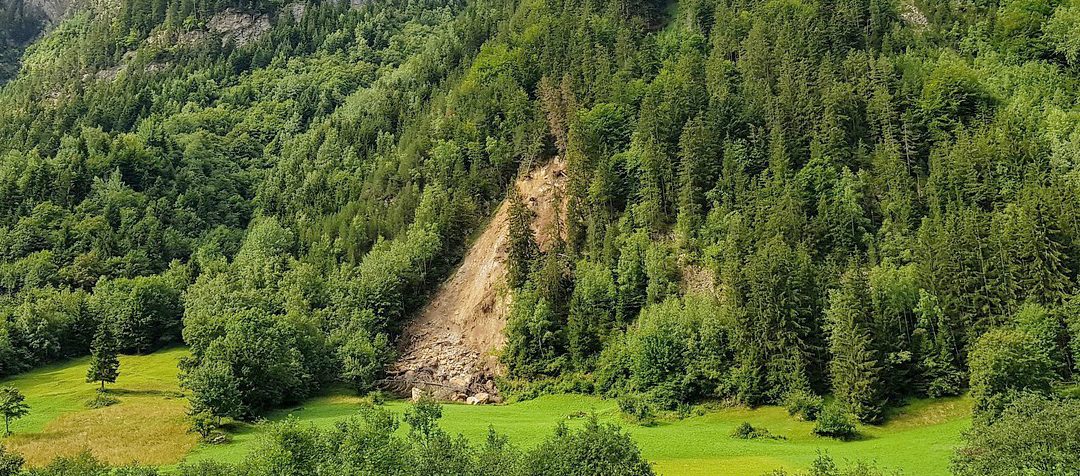The G&W Guide to… Slope Stability
Geotechnical
A slope stability assessment and report is required in areas where there is a history of, or potential for, slope instability. They are sometimes required to satisfy conditions imposed by the local authority and/ or warranty provider. Eurocode 7 says that slope stability should be a design concern for all developments, however, practically a quantitative assessment is usually only adopted where qualitative concerns are present.
Planning
The planning system has an important role in considering land stability by:
- Minimising the risk and effects of land stability on property, infrastructure and the public
- Helping to ensure that development does not occur in unstable locations or without appropriate precautions
- To bring unstable land, wherever possible, back into productive use.
When dealing with land that may be unstable, the planning system works alongside a number of other regimes, including:
- Building Regulations, which seek to ensure that any development is structurally sound
- The Coal Authority’s responsibility for public safety risks arising from past coal mining activities and dealing with proven claims for subsidence under the Coal Mining Subsidence Act 1991 and the Coal Industry Act 1994
- Consultation with the Cheshire Brine Subsidence Compensation Board, where land is subsiding or liable to subside owing to past brine pumping within a defined planning area
- The safeguarding of mine entries once they are abandoned to protect health and safety as required under the Mines and Quarries Act 1954
- A general duty on the site operator to ensure the safety of quarry excavations and tips; and that once abandoned the quarry is left in a safe condition, as required under the Quarries Regulations 1999.
What is the role of planners in planning for land instability in their areas?
Consideration of land stability in the development plan will vary between areas and the types of issues that the plan covers, but planning authorities may need to consider:
- Identifying specific areas where particular consideration of landslides, mining hazards or subsidence will be needed
- Including policies that ensure unstable land is appropriately remediated, prohibit development in specific areas, or only allow specific types of development in those areas
- Circumstances where additional procedures or information, such as a land stability or slope stability risk assessment report, would be required to ensure that adequate and environmentally acceptable mitigation measures are in place
- Removing permitted development rights in specific circumstances.
Types of Slope Failure
Slope failures depend on the soil type, soil stratification, groundwater, seepage, and the slope geometry.
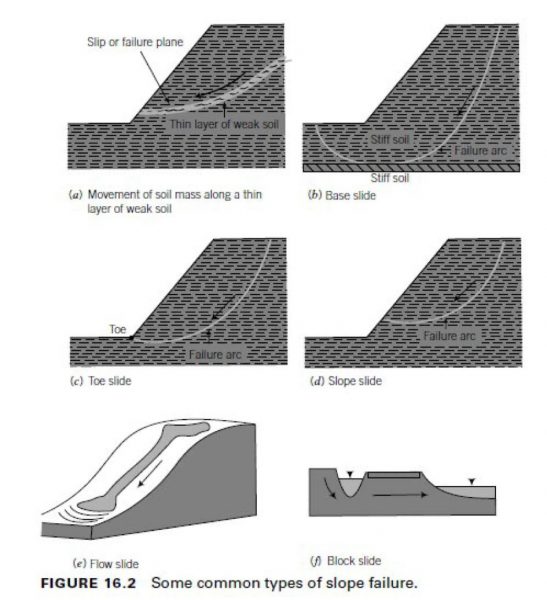 Here are a few types of slope failure that are common in soils.
Here are a few types of slope failure that are common in soils.
1. Translational Slide – Is failure of a slope along a weak zone of soil is called a translational slide (Figure 16.2a). The sliding mass can travel long distances before coming to rest. Translational slides are common in coarse-grained soils.
2. Rotational Slide – A common type of failure in homogeneous fine-grained soils is a rotational slide that has its point of rotation on an imaginary axis parallel to the slope. Three types of rotational failure often occur:
i. Base Failure – A soft soil layer resting on a stiff layer of soil is prone to base failure (Figure 16.2b).
ii. Toe Failure – The second type of rotational failure is the toe slide, whereby the failure surface passes through the toe of the slope (Figure 16.2c).
iii. Slope Failure – The third type of rotational failure is the slope slide, whereby the failure surface passes through the slope (Figure 16.2d).
One type, called a base slide, occurs by an arc engulfing the whole slope.
3. Flow Slide – A flow slide occurs when internal and external conditions force a soil to behave like a viscous fluid and flow down even shallow slopes, spreading out in several directions (Figure 16.2e). Multiple failure surfaces usually occur and change continuously as flow proceeds. Flow slides can occur in dry and wet soils.
4. Block or Wedge Slide – Block or wedge slides occur when a soil mass is shattered along joints, seams, fissures, and weak zones by forces emanating from adjacent soils. The shattered mass moves as blocks and wedges down the slope (Figure 16.2f).
Causes of Slope Failure.
Slope failures are caused, in general, by natural forces, human misjudgement (e.g. removal of trees without assessment / water pipe leaks etc) and activities, and burrowing animals.
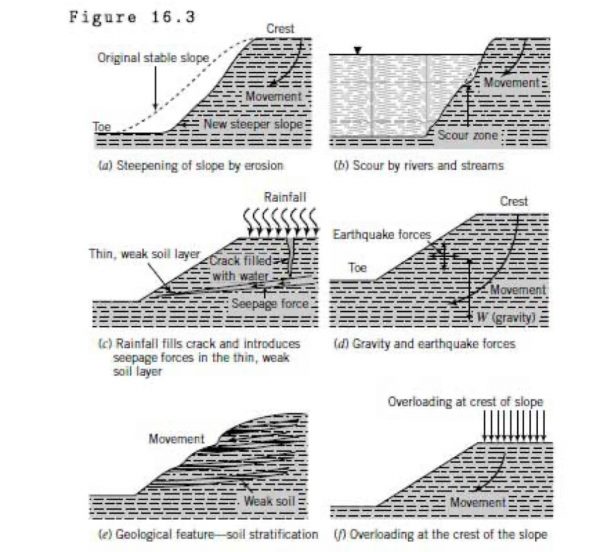 Below some of the main factors that provoke slope failures.
Below some of the main factors that provoke slope failures.
1. Erosion – Water and wind continuously erode natural and man-made slopes. Erosion changes the geometry of the slope (Figure 16.3a), ultimately resulting in slope failure or, more aptly, a landslide. Rivers and streams continuously scour their banks, undermining their natural or man-made slopes (Figure 16.3b).
2. Rainfall – Long periods of rainfall saturate, soften, and erode soils. Water enters into existing cracks and may weaken underlying soil layers, leading to slope failure, for example, mud slides (Figure 16.3c).
3. Earthquakes – Earthquakes induce forces (Figure 16.3d) that reduce the shear strength and stiffness of the soil.
4. Geological Features – Many failures commonly result from unidentified geological features. For example: A thin seam of silt (a few millimetres thick) under a thick deposit of stiff clay can easily be overlooked in drilling operations, or one may be careless in assessing borehole logs only to find later that the presence of the silt caused a catastrophic failure. Sloping, stratified soils are prone to translational slide along weak layers (Figure 16.3e).
5. External Loading – Loads placed on the crest of a slope (the top of the slope) add to the gravitational load and may cause slope failure (Figure 16.3f). A load placed at the toe will increase the stability of the slope.
6. Construction Activities – Construction activities near the toe of an existing slope can cause failure because lateral resistance is removed (Figure 16.3g).
THE ESSENTIAL POINTS ARE:
- Geological features and environmental conditions (e.g., external loads and natural forces) are responsible for most slope failures.
- The common modes of slope failure in soils are by translation, rotation, flow, and block movements.
How do you assess Slope Stability?
A Desk Study – This involves a review of the existing slope via site walkover and desk-based review of geological information or slope build up, to form an initial Conceptual Site Model. It is advantageous at this point to get a good topographic survey so that accurate cross-sections of the slope can be formed.
A Good Site Investigation – The broad aims of the SI will be to determine the make-up of the slope, the presence or absence of groundwater, and the effective properties of the material encountered. Data obtained based on the concerns raised by the CSM can also be tested. So, for example, this stage might be different for a railway embankment on Made Ground compared to a natural chalk cut/slope.
The two soil properties that concerns slope stability are:
Cohesion – Cohesion is basically the ability for soil particles to stick together. So this is relevant for clays or cohesive soils. Cohesion can be effective or residual depending on what has happened or is happening.
The Angle of Friction – An explanation of the Angle of Friction can be seen in the diagram below.
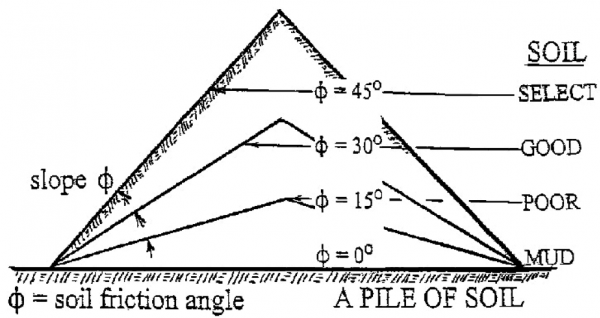
The typical Angle of Friction of materials can be seen in the diagram below.
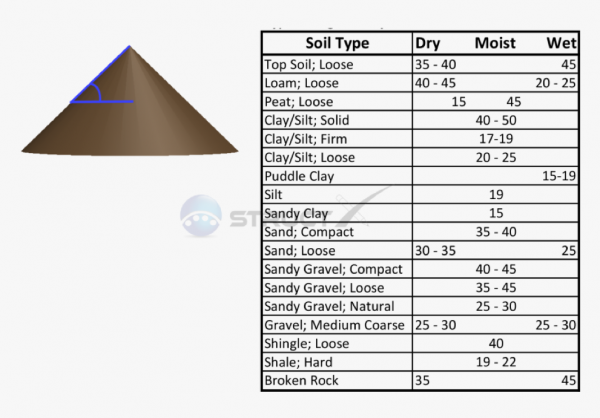
The aim of the SI will be to determine accurately what the characteristics of the soil properties are.
Principles of Eurocode 7 (EC7) for slope stability analysis
The assessment of the stability of slopes is governed by the general requirements of EC7 as expressed below:
Ed < Rd
Ed=design effect of actions
Rd=design resistance corresponding to that effect
A slightly simpler way of putting it is the slope must be balanced, with the stabilising actions balancing/outweighing the destabilising. This analysis is usually undertaken via computer modelling, using various equations formulated by experts in this field. (Bishops/Janbu, Morgenstein and Spencer).
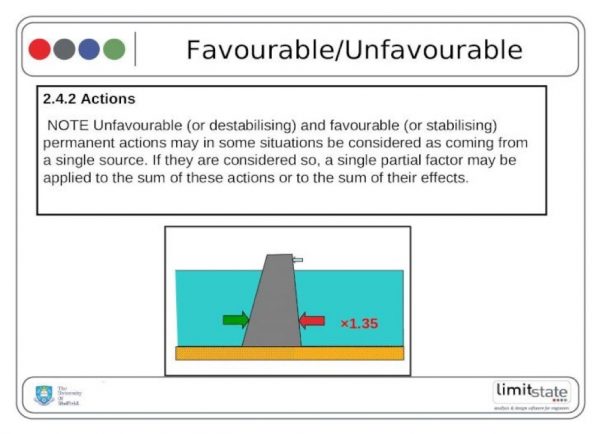 The Factor of Safety (FoS) on a slope is the Ratio of Favourable (Stabilising) v Unfavourable (Destabilising)
The Factor of Safety (FoS) on a slope is the Ratio of Favourable (Stabilising) v Unfavourable (Destabilising)
Put simply:
- If FoS = >1 The slope is SAFE
- If FoS = <1 The slope is UNSAFE
Note: Old British Standards used to calculate a FoS of ~1.25/1.30 (see below) or higher are acceptable for slope stability. The >1 approach takes into account partial factors: Which in EC7 DC2 has 1.25 on the Angle of Friction. Or EC7 DC1 1.35 on the unfavourable…So FoS already included in base inputs.

So how does Ground & Water fit into the slope stability equation?
Ground & Water’s geotechnical engineers can do the initial Desk Study and Site Walkover to determine if slope stability is a geotechnical concern. (The Geotechnical Risk Register will be referred to as part of this process).
We can then advise on the most appropriate Site Investigation to commission to get the best out of the ground.
We will then undertake all the detailed modelling (including proposed changes/retaining walls/piling) required to help identify the slope risk and how best to solve any risks.
